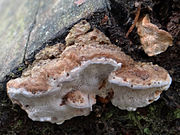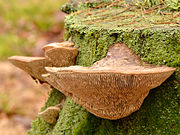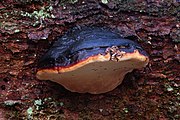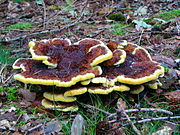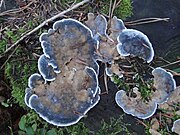Tree sponge relatives
| Tree sponge relatives | ||||||||||||
|---|---|---|---|---|---|---|---|---|---|---|---|---|

Fomitopsis pinicola , the red-rimmed tree sponge. |
||||||||||||
| Systematics | ||||||||||||
|
||||||||||||
| Scientific name | ||||||||||||
| Fomitopsidaceae | ||||||||||||
| Jülich (1982) |
The tree sponge relatives ( Fomitopsidaceae) are a family of fungi in the order of the stem porlings ( Polyporales ). The resupinate, console-shaped, fan-shaped or tongue-shaped porlings live saprobionic or parasitic on hardwood or coniferous wood and usually cause brown rot . Some species are noteworthy wood destroyers, most of which can attack wood that is lying down, but also partially built-up wood.
features
The annual or perennial fruiting bodies are resupinate, often with a bent back edge or console-shaped or fan-shaped. The meat is usually wooden, leathery or corky and the surface smooth or wrinkled or crusty. The hyphae can be dimitic or trimitic. The skeletal hyphae are usually well developed. The hymenium is poroid, the surface is usually pale or brownish in color, the pores can sometimes be labyrinth-like or almost lamellar. The hyaline, smooth, thin-walled basidiospores are ellipsoidal to cylindrical or allantoid and inamyloid .
Distribution and ecology
The family is widespread, especially in the northern temperate zone. The porlings live partly as saprobionts on woody substrate, partly as wound parasites on deciduous and coniferous trees that are still alive and produce brown rot. Some species can also break down built-in wood.
Genera
The family contains almost 400 described species and is divided into 33 genera. Some of the more species-rich or better-known genera are listed in the following table:
| Important and better known genera of tree sponge relatives |
meaning
Some species in the family are wound parasites, others attack the wood of important useful trees and some species attack wood that has already been used.
- The oak tangle ( Daedalea quercina ) can cause wound rot in various deciduous trees, especially oak. But mostly he lives saprobion table on oak stumps.
- The Birkenporling is a parasite on deciduous and coniferous trees. It was formerly used as a medicinal and tinder mushroom.
- The row of brown rot tramete ( Antrodia serialis ) mainly attacks lying softwood (mostly spruce) and thus causes some economic damage.
- The red-edged tree sponge ( Fomitopsis pinicola ) is a very common destroyer of hardwood and softwood. It causes intense brown rot and mostly affects wood that is lying down, but as a wound parasite it can also attack weakened, standing trunks. It occurs locally as a secondary pest to beech bark necrosis and, together with the tinder fungus ( Fomes fomentarius ), can cause total wood destruction in a short time.
- The house porling is an important pest on built-up hardwood and softwood.
- A common and widespread brown rot pathogen on hardwood with a colored core is the sulfur pore. It mostly attacks oaks and robinia and fruit trees. The wound parasite only decomposes the heartwood, which devalues the wood and increases the risk of wind breakage. The young fruiting bodies are edible and should taste like chicken, which is why the mushroom is also known as “chicken polypore” or “chicken-of-the-woods” in English-speaking countries.
- The coniferous brown spadiceus ( Phaeolus spadiceus ) is also an important and widespread wood destroyer. It mainly attacks pines, but also other conifers. The fungus grows in over the roots and causes severe brown rot. The fungus causes major economic damage, especially in western Europe, which is dominated by the ocean.
Web links
- W. Jülich: Fomitopsidaceae. In: Mycobank. International Mycological Association, accessed February 16, 2015 .
Individual evidence
- ↑ a b c d PF Cannon, PM Kirk: Fungal Families of the World . CAB International, 2007, ISBN 978-0-85199-827-5 , pp. 127-128 ( books.google.com ).
- ^ Jens H. Petersen, Thomas Læssøe: about the genus Antrodia. In: MycoKey. Accessed February 16, 2015 .
- ↑ Jens H. Petersen, Thomas Læssøe: about the genus Auriporia. In: MycoKey. Accessed February 16, 2015 .
- ↑ Jens H. Petersen, Thomas Læssøe: about the genus Climacocystis. In: MycoKey. Accessed February 16, 2015 .
- ↑ Jens H. Petersen, Thomas Læssøe: about the genus Dacryobolus. In: MycoKey. Accessed February 16, 2015 .
- ^ Jens H. Petersen, Thomas Læssøe: about the genus Mazegill (Daedalea). In: MycoKey. Accessed February 16, 2015 .
- ^ Jens H. Petersen, Thomas Læssøe: about the genus Donkioporia. In: MycoKey. Accessed February 16, 2015 .
- ↑ Jens H. Petersen, Thomas Læssøe: about the genus Fomitopsis. In: MycoKey. Accessed February 16, 2015 .
- ↑ Jens H. Petersen, Thomas Læssøe: about the genus bracket (Ischnoderma). In: MycoKey. Accessed February 16, 2015 .
- ↑ Jens H. Petersen, Thomas Læssøe: about the genus Chicken of the Woods (Laetiporus). In: MycoKey. Accessed February 16, 2015 .
- ↑ Jens H. Petersen, Thomas Læssøe: about the genus Osteina. In: MycoKey. Accessed February 16, 2015 .
- ↑ Jens H. Petersen, Thomas Læssøe: about the genus Parmastomyces. In: MycoKey. Accessed February 16, 2015 .
- ↑ Jens H. Petersen, Thomas Læssøe: about the genus Mazegill (Phaeolus). In: MycoKey. Accessed February 16, 2015 .
- ↑ Jens H. Petersen, Thomas Læssøe: about the genus Oak Polypore (Piptoporus). In: MycoKey. Accessed February 16, 2015 .
- ^ Jens H. Petersen, Thomas Læssøe: about the genus Pycnoporellus. In: MycoKey. Accessed February 16, 2015 .
- ↑ Jens H. Petersen, Thomas Læssøe: about the genus bracket (Postia). In: MycoKey. Accessed February 16, 2015 .
- ↑ P. Schütt, HJ Schuck, B. Stimm: Lexicon of tree and shrub species . The standard work of forest botany. Morphology, pathology, ecology and systematics of important tree and shrub species. Nikol, Hamburg 2002, ISBN 3-933203-53-8 .

